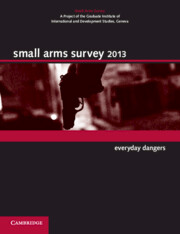Book contents
- Frontmatter
- Foreword
- Contents
- About the Small Arms Survey
- Notes to readers
- Acknowledgements
- Introduction
- Chapter 1 Everyday Dangers: Non-conflict Armed Violence
- Chapter 2 Too Close to Home: Guns and Intimate Partner Violence
- Chapter 3 Turning Points: Gang Evolution in Nicaragua
- Chapter 4 Guns in the Family: Mafia Violence in Italy
- Chapter 5 Survival at Stake: Violent Land Conflict in Africa
- Chapter 6 Trend Lines: Armed Violence in South Africa pages 132 to 137
- Chapter 6 Trend Lines: Armed Violence in South Africa pages 137 to 159
- Chapter 7 Second Wind: The PoA's 2012 Review Conference pages 160 to 168
- Chapter 7 Second Wind: The PoA's 2012 Review Conference pages 169 to 177
- Chapter 8 Trade Update: Authorized Small Arms Transfers
- Chapter 9 Burning the Bullet: Industrial Demilitarization of Ammunition pages 186 to 199
- Chapter 9 Burning the Bullet: Industrial Demilitarization of Ammunition pages 200 to 217
- Chapter 10 ‘Infernal Machines’: Improvised Explosive Devices
- Chapter 11 Price Watch: Arms and Ammunition at Illicit Markets pages 250 to 268
- Chapter 11 Price Watch: Arms and Ammunition at Illicit Markets pages 269 to 281
- Chapter 12 Captured and Counted: Illicit Weapons in Mexico and the Philippines pages 282 to 302
- Chapter 12 Captured and Counted: Illicit Weapons in Mexico and the Philippines pages 302 to 317
- Index
Chapter 4 - Guns in the Family: Mafia Violence in Italy
Published online by Cambridge University Press: 05 June 2014
- Frontmatter
- Foreword
- Contents
- About the Small Arms Survey
- Notes to readers
- Acknowledgements
- Introduction
- Chapter 1 Everyday Dangers: Non-conflict Armed Violence
- Chapter 2 Too Close to Home: Guns and Intimate Partner Violence
- Chapter 3 Turning Points: Gang Evolution in Nicaragua
- Chapter 4 Guns in the Family: Mafia Violence in Italy
- Chapter 5 Survival at Stake: Violent Land Conflict in Africa
- Chapter 6 Trend Lines: Armed Violence in South Africa pages 132 to 137
- Chapter 6 Trend Lines: Armed Violence in South Africa pages 137 to 159
- Chapter 7 Second Wind: The PoA's 2012 Review Conference pages 160 to 168
- Chapter 7 Second Wind: The PoA's 2012 Review Conference pages 169 to 177
- Chapter 8 Trade Update: Authorized Small Arms Transfers
- Chapter 9 Burning the Bullet: Industrial Demilitarization of Ammunition pages 186 to 199
- Chapter 9 Burning the Bullet: Industrial Demilitarization of Ammunition pages 200 to 217
- Chapter 10 ‘Infernal Machines’: Improvised Explosive Devices
- Chapter 11 Price Watch: Arms and Ammunition at Illicit Markets pages 250 to 268
- Chapter 11 Price Watch: Arms and Ammunition at Illicit Markets pages 269 to 281
- Chapter 12 Captured and Counted: Illicit Weapons in Mexico and the Philippines pages 282 to 302
- Chapter 12 Captured and Counted: Illicit Weapons in Mexico and the Philippines pages 302 to 317
- Index
Summary
INTRODUCTION
In the span of 52 days in 1992, two horrific bomb attacks in Palermo killed Sicilian judges Giovanni Falcone and Paolo Borsellino, Falcone's wife Francesca Morvillo, and eight police agents who were part of their armed escorts. The murders provoked mass demonstrations against the mafia in Italy and marked the beginning of a stunning escalation of violence by the Sicilian mafia against the Italian state. Tensions culminated with a terrorist bombing campaign on the mainland in 1993, when bombs planted in Florence, Milan, and Rome killed ten people and wounded more than 70 (CPIFCOMS, 2010a, pp. 10-11). The impressive amount of explosives used in these ‘military-style’ actions provoked public astonishment and harsh law enforcement countermeasures, unprecedented in the contemporary history of Italian mafia operations.
The Sicilian mafia, like similar organized crime groups based in Italy, has always adopted violence as a last resort, namely when preferred alternatives-such as non-violent displays of strength or threats—cannot achieve the same results. Yet the professionalized use of firearms and explosives remains a characteristic feature of mafia organizations. The use of violence and intimidation against competitors and opponents enables these groups to enhance their reputation and acquire privileged positions in the markets in which they operate, whether legal or illegal. Thus, mafia-type organizations have generally relied on the availability of weapons.
- Type
- Chapter
- Information
- Small Arms Survey 2013Everyday Dangers, pp. 74 - 101Publisher: Cambridge University PressPrint publication year: 2013



